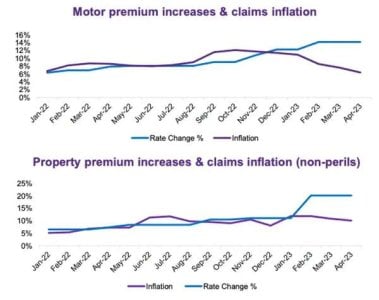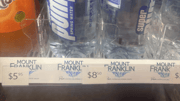Learn how to dodge up to a 20 per cent premium hike by Australian firms
Hello, SDC members! While life may not always be a leisurely walk in the park, we, at the Seniors Discount Club, strive to assist you in navigating through potential obstacles.
Today, we are addressing the less-than-pleasant subject of insurance premium hikes.
Insurance Australia Group (IAG), behind NRMA Insurance and SGIO, is scheduling a hefty 14 per cent increase in motor premiums and a 20 per cent rise in property premiums.
Suncorp, the closest competitor, owning renowned brands such as AAMI and Apia, is also experiencing an unprecedented surge in rate increases.
This surge signifies a new era of premium hikes, growing at the swiftest pace seen in the past decade.
The industry at large has defended its decisions by blaming price accelerations, escalated natural disasters, and ballooning labour, parts, and repair costs.
A spokesperson of IAG said, ‘We weigh up a number of factors when determining any premium increases. This is something we’ve been particularly conscious of over the past year following the number of major weather events.’
However, the rising premium tide does not mean we should deal with drowning.
The market is varied, so much so that the chasm betweenpricey and reasonable policies is broadening.
Remember how loyalty got you those extra stickers on your coffee loyalty card? In the world of insurance, it could just be leaving you out of pocket.
According to IBISWorld Senior Industry Analyst Danny Martin, 'A lot of the major insurance companies compete heavily on branding... It’s hard for them to differentiate themselves because their products are very similar.'
Instead of being swayed by the bombarding ads, take time to scrutinise the fine print and draw comparisons.
Be it your faithful ride or your cherished home, there are several strategies to curb the insurance pinch. Most of these, thankfully, are as simple as scrutinising your existing policy a bit more keenly.
Let's discuss motor insurance first. The reality is with increased parts and repair costs; premiums are certainly looking north. Pandemic-related disruptions have made new cars a rarer breed, forcing many to cling onto their older beauties. If this situation resonates with you, there's no need to lose hope.
Firstly, consider lifting your excesses as a higher upfront cost at the time of a claim could result in smaller premiums.
If under-25 drivers don't frequent your vehicle, consider excluding their coverage too.
A lesser-known trick—if you drive less than 10,000km a year, a discount might be ripe for the taking.
Lastly, evaluate additional features like a hire-car post-accident and check if your vehicle's assigned replacement value is accurate.

For your beloved abode, a similar strategy of upping the excess can be beneficial in lowering the annual premium amount.
As for the value of your building and contents policy, ensure it is readjusted each year to avoid unwarranted increases.
It's also worth noting with some insurers that paying annually usually works out cheaper than monthly premiums, and it pays to checkif discounts for holding multiple policies or no-claims bonuses are correctly applied.

Members, what are your thoughts on the rising insurance premium hikes by companies like Insurance Australia Group and Suncorp? Do you have any strategies or tips for avoiding excessive premium increases?
Today, we are addressing the less-than-pleasant subject of insurance premium hikes.
Insurance Australia Group (IAG), behind NRMA Insurance and SGIO, is scheduling a hefty 14 per cent increase in motor premiums and a 20 per cent rise in property premiums.
Suncorp, the closest competitor, owning renowned brands such as AAMI and Apia, is also experiencing an unprecedented surge in rate increases.
This surge signifies a new era of premium hikes, growing at the swiftest pace seen in the past decade.
The industry at large has defended its decisions by blaming price accelerations, escalated natural disasters, and ballooning labour, parts, and repair costs.
A spokesperson of IAG said, ‘We weigh up a number of factors when determining any premium increases. This is something we’ve been particularly conscious of over the past year following the number of major weather events.’
However, the rising premium tide does not mean we should deal with drowning.
The market is varied, so much so that the chasm betweenpricey and reasonable policies is broadening.
Remember how loyalty got you those extra stickers on your coffee loyalty card? In the world of insurance, it could just be leaving you out of pocket.
According to IBISWorld Senior Industry Analyst Danny Martin, 'A lot of the major insurance companies compete heavily on branding... It’s hard for them to differentiate themselves because their products are very similar.'
Instead of being swayed by the bombarding ads, take time to scrutinise the fine print and draw comparisons.
Be it your faithful ride or your cherished home, there are several strategies to curb the insurance pinch. Most of these, thankfully, are as simple as scrutinising your existing policy a bit more keenly.
Let's discuss motor insurance first. The reality is with increased parts and repair costs; premiums are certainly looking north. Pandemic-related disruptions have made new cars a rarer breed, forcing many to cling onto their older beauties. If this situation resonates with you, there's no need to lose hope.
Firstly, consider lifting your excesses as a higher upfront cost at the time of a claim could result in smaller premiums.
If under-25 drivers don't frequent your vehicle, consider excluding their coverage too.
A lesser-known trick—if you drive less than 10,000km a year, a discount might be ripe for the taking.
Lastly, evaluate additional features like a hire-car post-accident and check if your vehicle's assigned replacement value is accurate.

Rising insurance premium hikes can have a significant impact on individuals' financial burdens, making it more challenging to afford necessary coverage. Image by rarchitecture_melbourne from Unsplash
For your beloved abode, a similar strategy of upping the excess can be beneficial in lowering the annual premium amount.
As for the value of your building and contents policy, ensure it is readjusted each year to avoid unwarranted increases.
It's also worth noting with some insurers that paying annually usually works out cheaper than monthly premiums, and it pays to checkif discounts for holding multiple policies or no-claims bonuses are correctly applied.
Key Takeaways
- Insurance Australia Group, the largest general insurer in the country, will raise motor premiums by 14 per cent and property premiums by 20 per cent, according to reports.
- Suncorp is also increasing its rates at the fastest rate in a decade.
- Some ways to save on car insurance include opting for higher excesses, removing cover for under-25 drivers if not necessary, and checking if less mileage qualifies for a discount. Furthermore, it is advised to reassess if the replacement value assigned to the vehicle is correct and if promised discounts are being applied correctly
- To reduce your annual premium, consider increasing your excess and annually readjusting the value of your building and contents policy. Additionally, paying annually instead of monthly and verifying the correct application of discounts or no-claims bonuses can lead to potential savings.
Members, what are your thoughts on the rising insurance premium hikes by companies like Insurance Australia Group and Suncorp? Do you have any strategies or tips for avoiding excessive premium increases?








